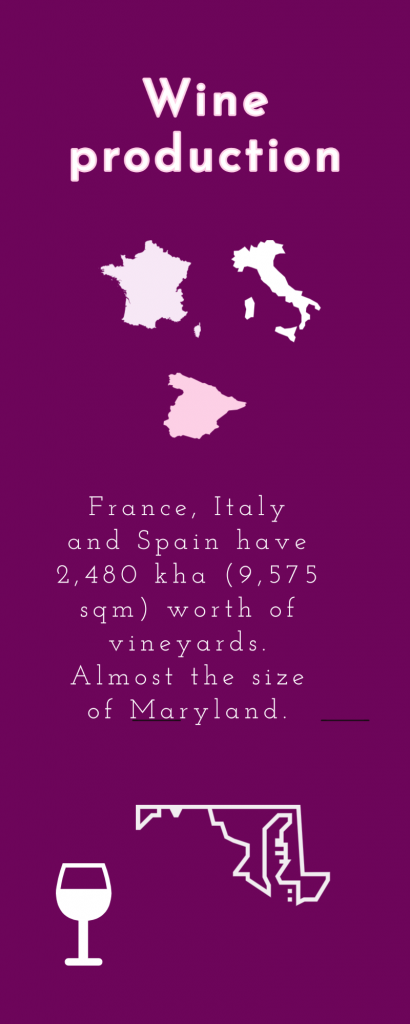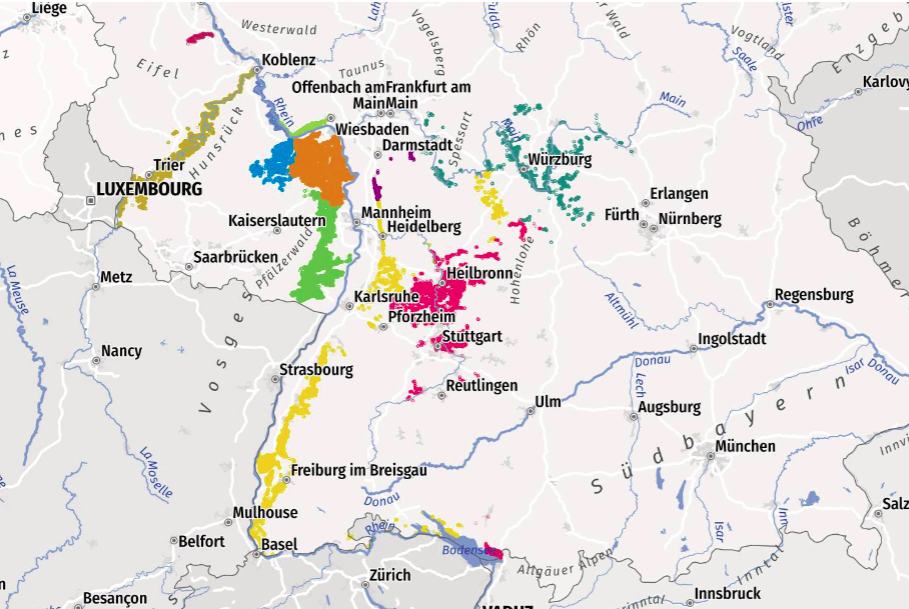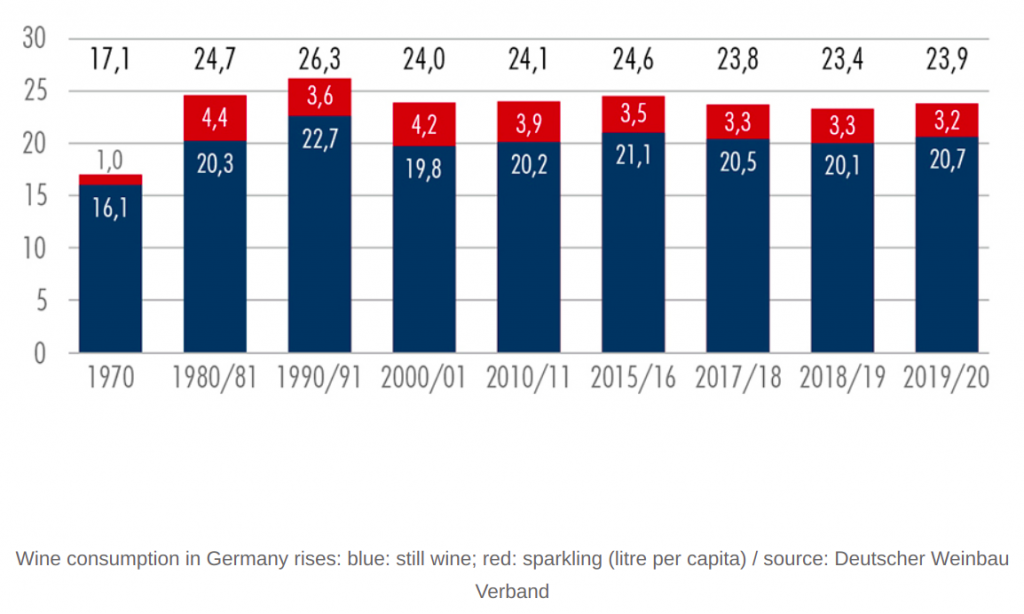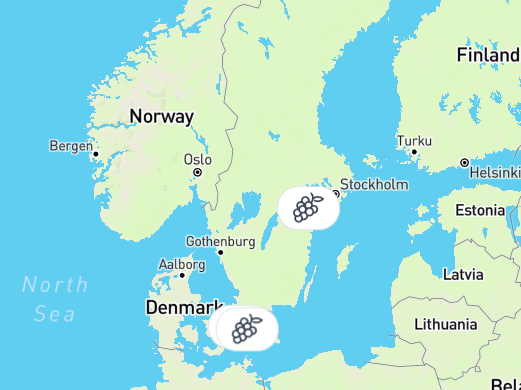xtraWine reviews their data on wine consumption in Northern Europe and reflects on the growth of wine production in Germany and Scandinavian countries.
In April 2022 the International Organisation of Vines and Wines published a report on the state of the world of wine production, export and consumption in Europe and around the Globe.
According to the report, Europe remains world leader in the production, consumption and export of wine.
Spain, Italy and France remain unrivaled producers and exporters of wines internationally. These countries also own some of the largest vineyard surface in the world. Combined, in fact, they have 2,480 kha (9,575 sqm) worth of vineyards. Almost the size of Maryland.

Follow, in order of importance, Iran and China which are driving the world vineyard’s surface upward. These positive data, however, do not compensate for the loss of land and vineyards due to global warming, which is causing extreme weather conditions. Amongst the countries that have lost land dedicated to wine production are Portugal, Romania and Hungary, USA (California) and Turkey.
What is most interesting however, is the growth of land dedicated to vineyards and wine-production in countries traditionally known to produce (and consume) beer in the Norther parts of Europe. This is the case of countries like Germany, Sweden and Denmark.
Germany: from beer tradition to wine production
Beer is the drink representative of Germany.
In 1886, an American consul named George C. Tanner, stationed in Chemnitz (Germany), wrote, “Beer is the national beverage, and is used as such, if not to a greater extent than water, then assuredly equally so.”
This alcoholic drink is so central to German culture, that the right to drink beer used to be written into some labour contracts and there exists a law – introduced in 1516 – stipulating that only water, barley and hops were allowed to be used as key ingredients for beer production. They certainly forgot yeast but this is the topic for another story!
However, latest data from the Federal Statistical Office (Destatis) reveal that beer sales dropped by 2.2% in 2021 compared to 2020. This decline confirms a general trend that started nearly three decades ago.
In fact, the average consumption of beer per person in the mid-1970s was about 150lt (one pint a day); this declined dramatically in the 1990s, when the average personal consumption had dropped to 144.9lt. In 2021 this amount dropped to 101lt per year (less than half a pint per day). This decrease can be attributed to multiple factors, from healthier life styles to rising costs of beer.
The decline of beer production and consumption has been balanced by a newer interest toward wine.
Germany’s wine Regions
Germany’s consumption of wine has increased tremendously, thanks also to Covid-19. Likewise, Germany -alongside Austria and Switzerland- is now an internationally established producer of great white wines. The key regions known for their wine production are:
Ahr
Moselle-Saar-Ruwe
Middle Rhine
Rheingau
Nahe
Hessen Renana
Palatinate
Hesse Bergstraße
Bergstraße
Franconia
Württemberg
Baden

All these regions are located along the Rhine. However, after the re-unification of the country, the easternmost regions of Saale-Unstrut and Saxony were added to the list.
The atmospheric conditions of these regions are very favourable for the cultivation of the vines. The massifs around the Rhine in the Moselle valley, in fact, protect the vineyards from the cold and the winds of the North, ensuring a temperate climate, never subject to frost.
German wine consumption
Since 2020, due to Covid, German consumers -along with many other fellow consumers in Europe and worldwide- started to buy wine online. According to the German Wine Institute, German consumers prefer white wines.

However, we have recorded an increase in orders of Italian red wines, especially from customers in the Berlin and Munich area. Although the preference of red wines is a constant in our Europe’s operations, we found the data especially interesting because they seem to tell a different story about wine consumption preference vs wine production habits and capabilities.
Additionally, like many other retailers in Europe, we observed that food prices and inflation above 6% have had a major impact on German consumers’ confidence in the first three months of 2022.
Nevertheless, wine Made in Italy retains its appeal and our data show that the country regained some confidence right away after the first few months of 2022.
Our data is corroborated by reports on the first quarter of 2022 – one of the worst time experienced in the history of world trade. Italian wine exports reached 1.7 billion euros, 15.5% of which were exported to Germany.
German wine production: who drinks German wines?
The increased consumption of wine is also matched by the stable export of German wines. XtraWine has registered an interest toward German wines from northern European countries like Finland, Austria, Switzerland and Sweden in 2022.
German wines are, in fact, very appreciated in the Nordic countries. At the end of 2021 the Finnish Alcohol monopoly ALKO confirmed that of all the white wine sold in Finland in 2020 and 2021, 20.2% was German wine. Other popular destinations of German wine exports also include the US and the Netherlands.
Scandinavian wine production: Sweden
Scandinavian countries too are known for their beers rather than their wines. Nevertheless, wine production and consumption are on the rise in the Nordic countries, despite the monopoly and the restrictions on wine marketing and advertising.
Sweden is perhaps the least known wine producer and yet, the country has started experimenting on wine production in the early 2000s in the southern part of the country. Likewise, Denmark has invested on viticulture, making an interesting switch from beer production and consumption to wine production. Sweden has recently started to produce its own grape variety known as Solaris, a grape]of German origin created in the 1970s and used for white wines. The variety that is grown in Sweden is the green grapes, which ripens better and faster. Other grape varieties grown in the country to produce white wine include Rondo, Cabernet Cortis, Muscaris and Souvignier Gris. There are two main wine regions in Sweden to visit wineries, Scania and Södermanland.

Though Sweden’s wine production is mainly geared toward still wines, there are great examples of sparkling whites, produced using Méthode Champenoise.
Sweden wine consumption
Sweden is one of xtraWine’s markets. Our data show that Sweden has a preference for organic wines, predominantly red wines, followed by Italian sparkling wines. One of the most interesting facts that we have extrapolated from our data is that the average order value has increased since 2020, despite the international recession and the country’s decreased growth. Our data confirm recent research from Wine Intelligence that shows that the average Swedish customer is willing to spend up to 50 EUR per bottle of wine, and that the consumption of red wines and sparkling wines are on the rise in the country.
Sweden wine production: who drinks Swedish wines?
There are currently 40 wine producers in the country and although the production does not have a significant impact on the GDP and cannot be considered an important contributor to the country’s economy, Sweden was the 39th world wine exporter in 2021.
The main destinations of Swedish wines are: Denmark ($6.22M), Finland ($4.91M), Norway ($3.46M), Germany ($1.48M), and Estonia ($757k)
Although there are some worries that the love story with wine may be coming to an end in Sweden, these numbers are significant and Swedish wine production certainly deserves to be monitored.
What shall we take from this data? Wine is an important business for Northern European countries. The Nordics and Germany are showing a great potential both, as producers and exporters of great wines, as well as consumers. Monitoring these countries and understanding how consumption and production will evolve is key to commercial success in the future. And xtraWine will continue to monitor how these countries evolve and mature.










